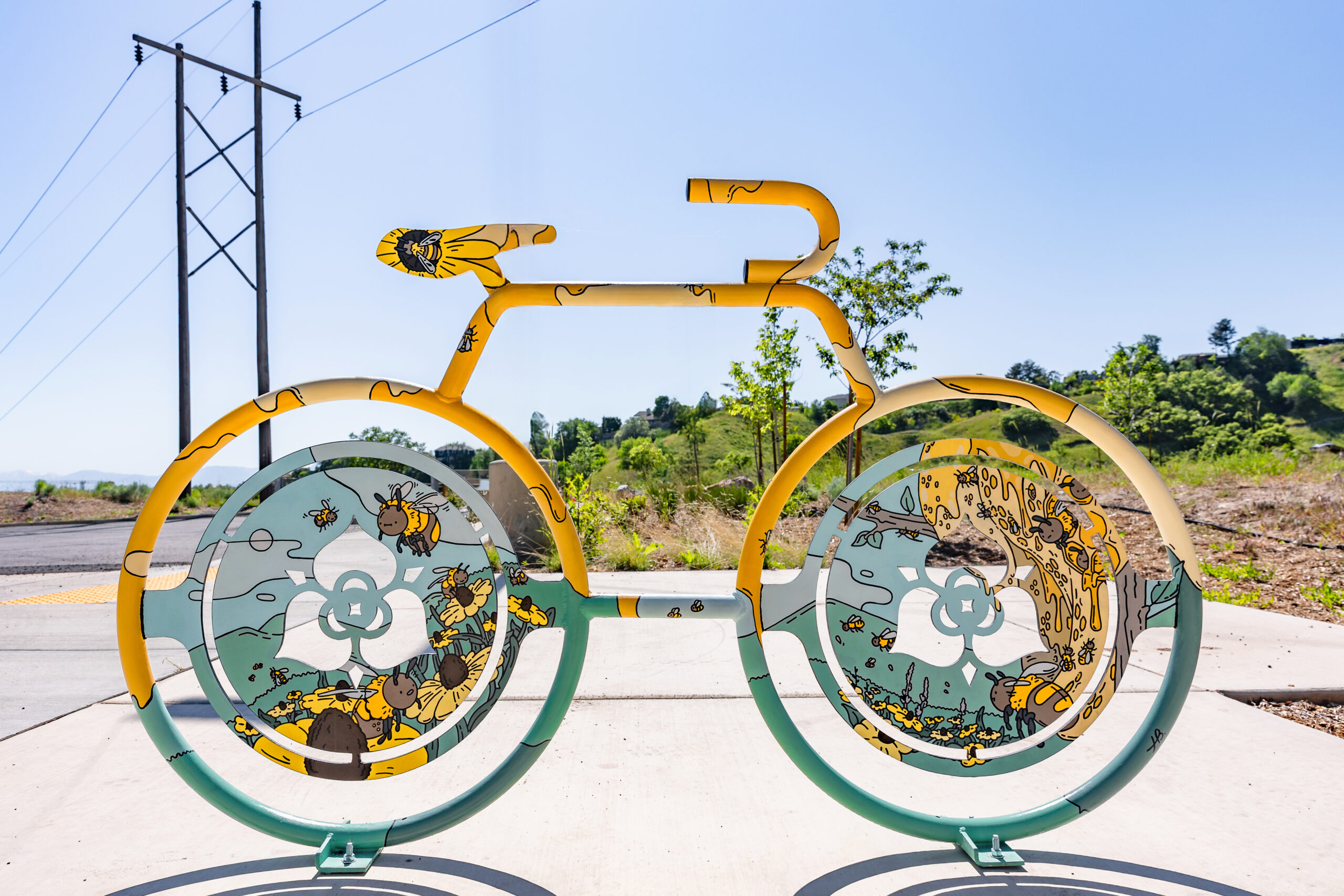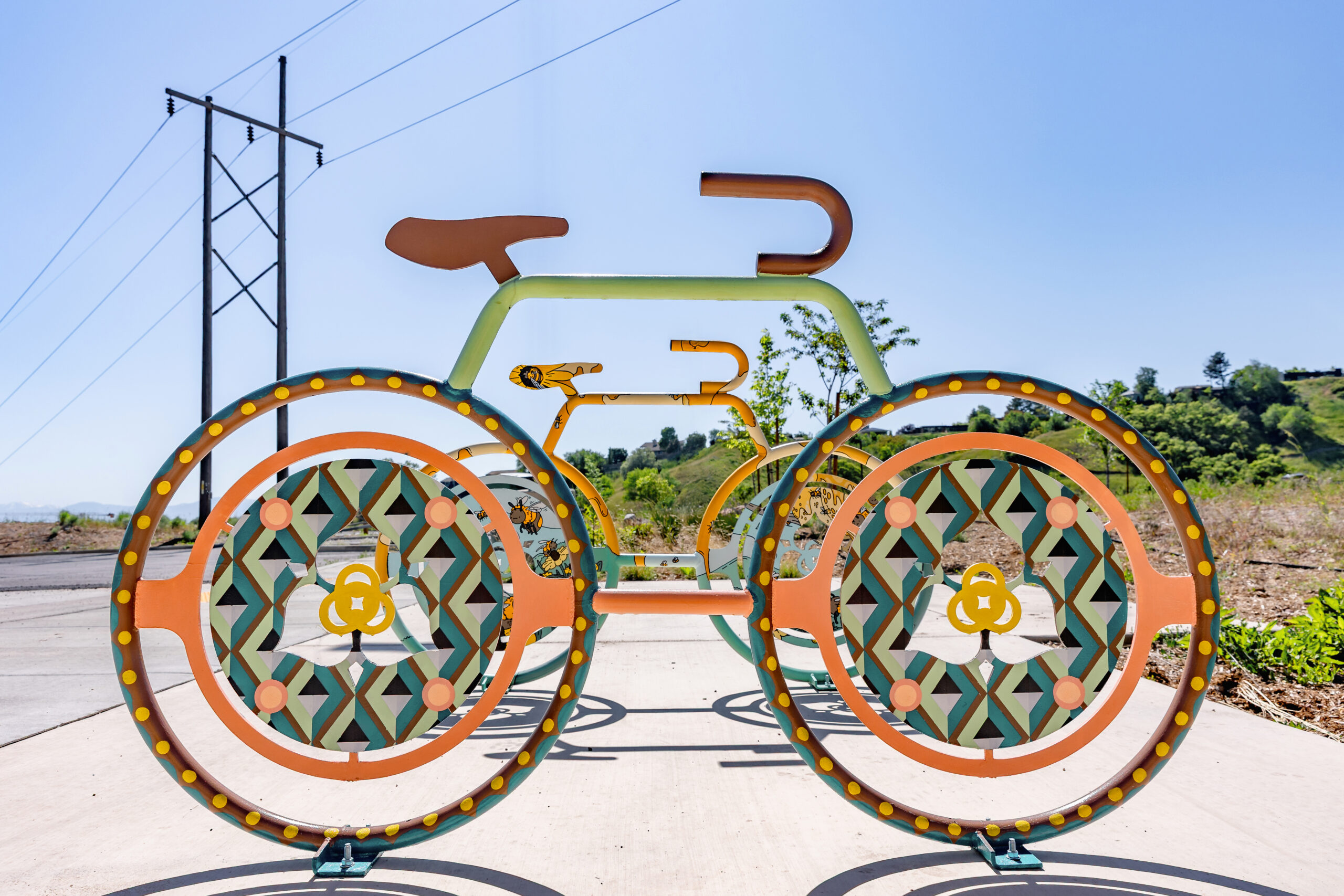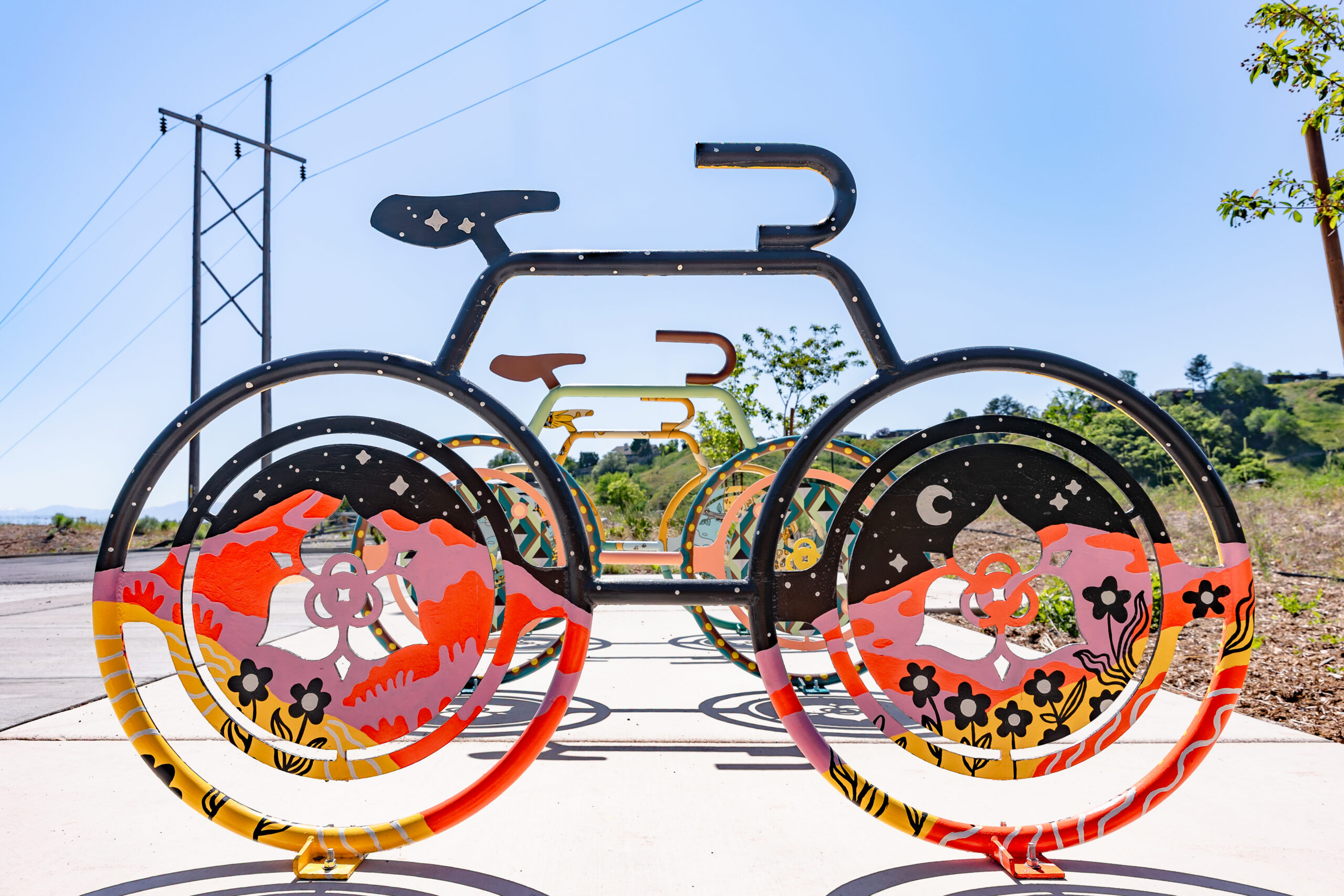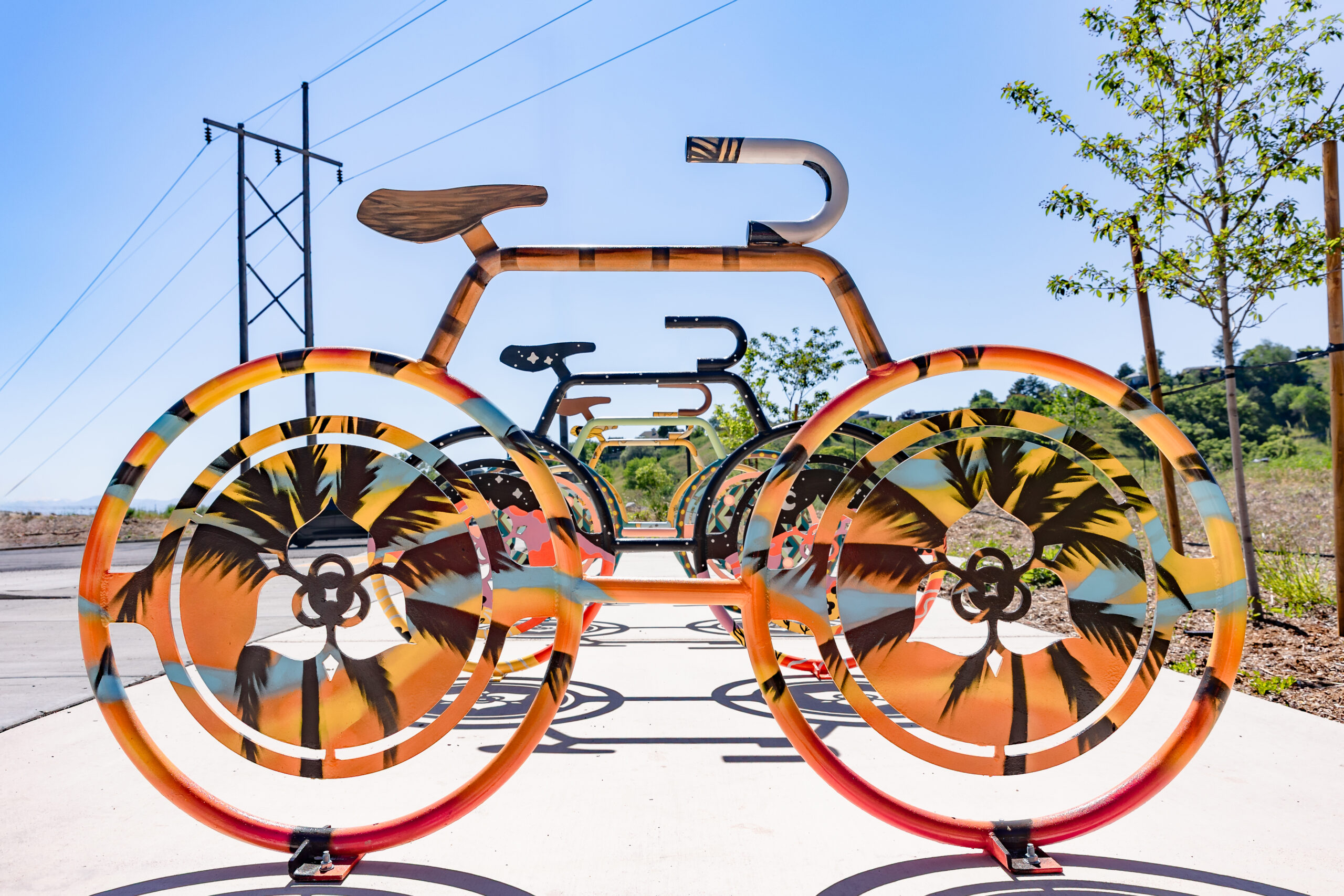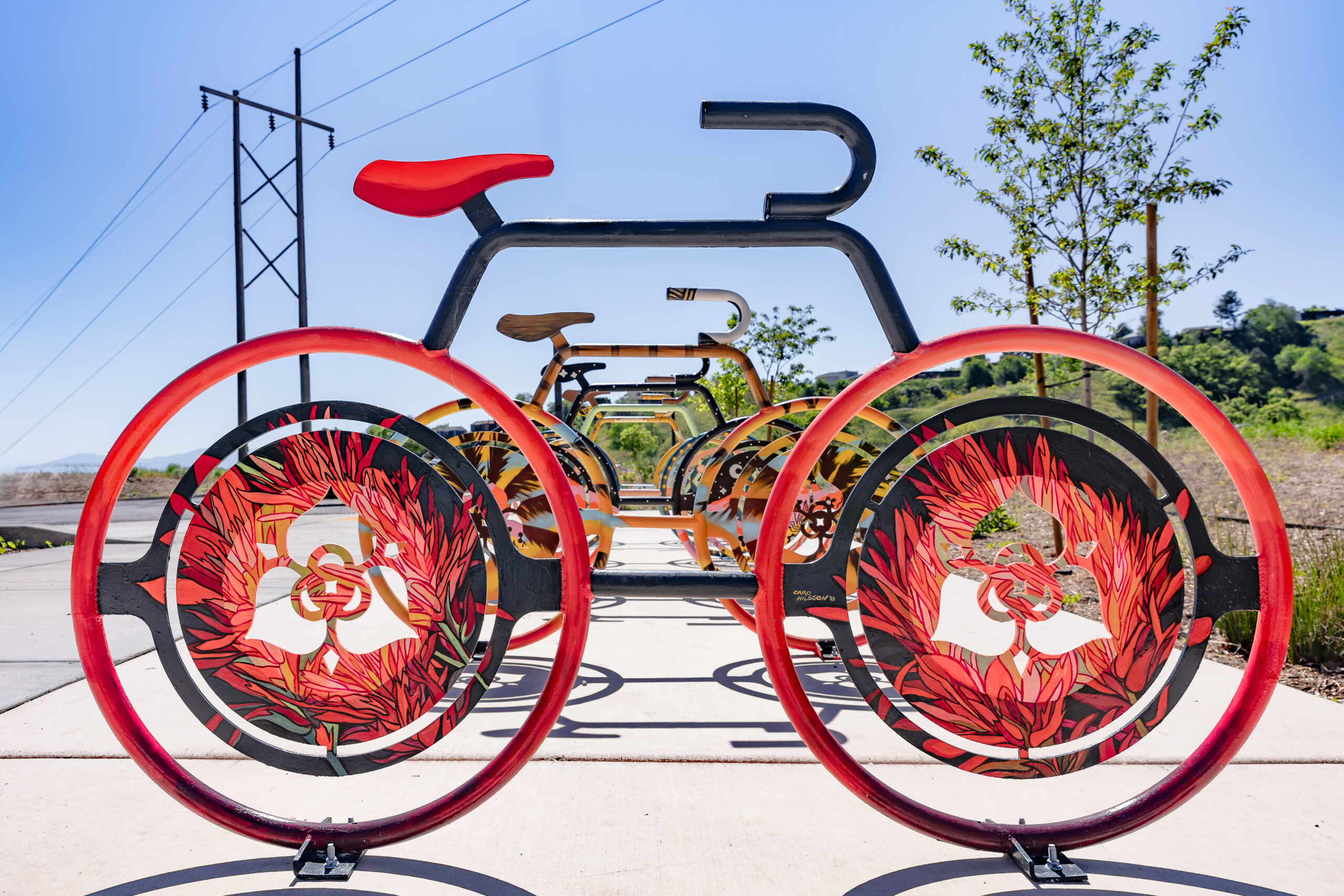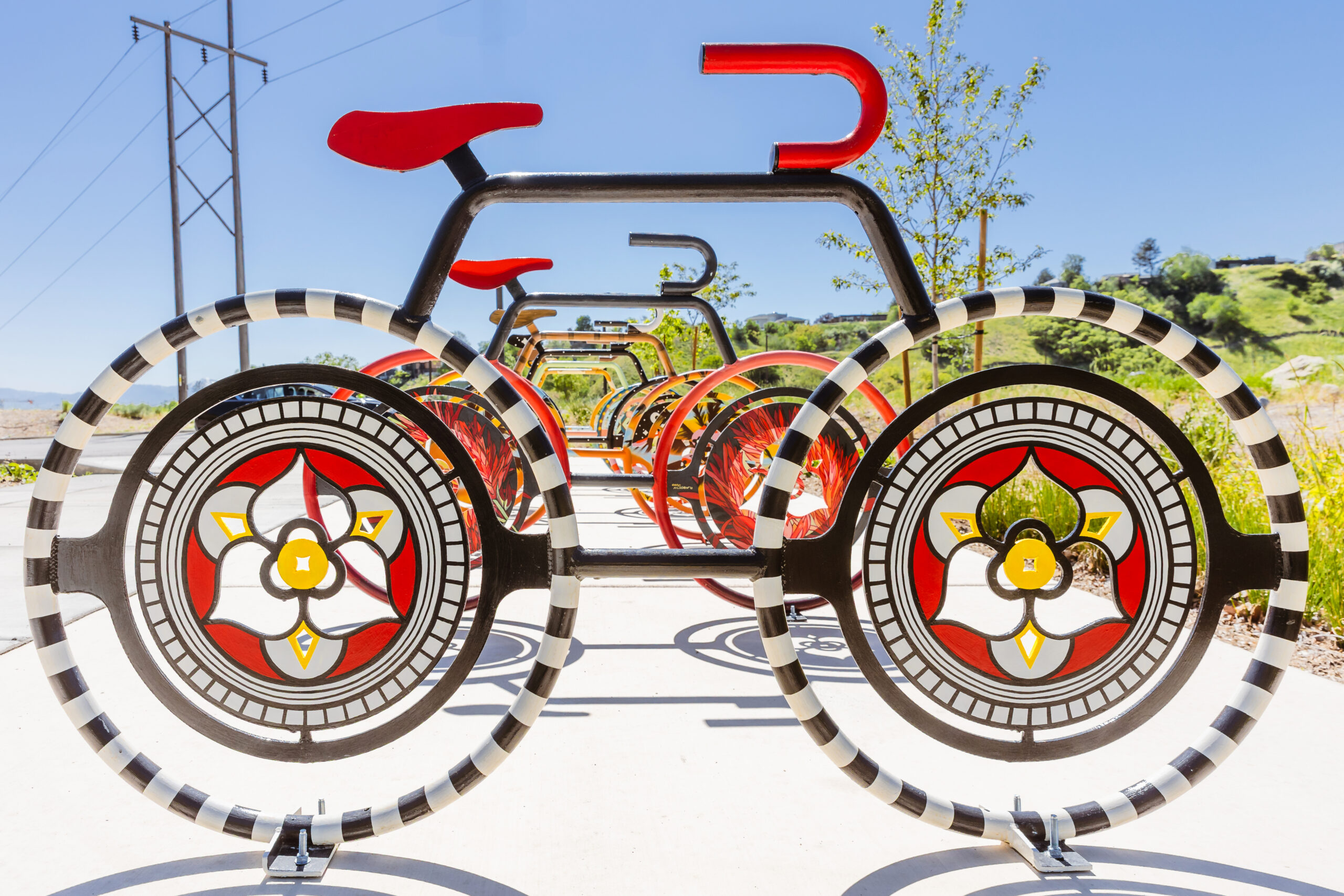The reimagined Seven Canyons Fountain incorporates new sculptural and design elements that invite visitors to engage with Salt Lake City’s landscapes, histories, and ecosystems in renewed and meaningful ways. Highlights include “People Perches”—cast bronze sculptures that encourage visitors, to explore birdsong through sound, touch, braille, and sonogram forms—and cast bronze site repairs inspired by kintsugi, the Japanese art of golden mending, symbolizing resilience and renewal. Shishi-odoshi water features at each canyon headwater engage visitors in hands-on water stewardship, while a representation of Salt Lake City’s historic streetcar lines, powered by Big Cottonwood Creek, connects the city’s transportation history to its hydrological systems. Additional elements include etched granite tile cairns —designed by Rios Pacheco of the Northwest Band of the Shoshone Nation and artists with the Noun Project—and a redesigned Great Salt Lake feature, reimagined as a spiral to encourage play and education.
Woven together, these elements reflect five core themes: our relationships with sister species (especially birds); the interconnected water systems of the Bonneville Basin; the legacies of the region’s First Peoples; stewardship and healing of meaningful places; and expanded access to multi-sensory experiences. Artist Stephen Goldsmith collaborated with experts in ornithology, accessibility, and sound design—including Alma Schrage, Milad Mozari, the Cornell Lab of Ornithology, and Tracy Aviary—to create an immersive and inclusive public experience. Embedded QR codes link visitors to curated audio content, extending the artwork’s reach beyond the site itself.
Photo Credit: Logan Sorenson
________________________________________________________________
Seven Canyons Refuge: A Prelude
Artist Statement by Stephen Goldsmith
Origins of the Refuge
In 1991 Dr. Obert C. Tanner invited architect Boyd Blackner and me to design a place where people could share his love of water and celebrate its life-giving force in the valley. Together with Boyd’s daughter, architect Elizabeth Blackner, we asked questions about place, people, and water – the group of us asking questions shaped the form of the Seven Canyons Fountain when it opened in 1993.
From Fountain to Refuge
The reemergence of the space comes at a time when the community is facing urgent challenges about water in the valley, especially the future of the Great Salt Lake. Our relationships with water, and the complex ways it connects us to other species and to each other, are now central questions. There is broad community recognition that this place holds value, should not be discarded, and can be repaired. As a metaphor, it invites us to ask: what kinds of repairs might we make in other places, with people, communities, or even ourselves?
We hope that our reimagining of Dr. Tanner’s gift might inspire new, creative responses to these challenges. The child who brings Legos to the refuge to build imaginary neighborhoods, the child who climbs the boulders with or without the fear of falling, the child who sails up the hill on wheels…these people may one day become designers of the city itself.
The Land Changes
In light of these challenges, the new collaborative team has preserved the fountain’s infrastructure in hopes that one day this space—once a refuge from summer heat—might provide cool respite again. The boulders throughout the refuge come from the seven canyons of the rivers that feed the Great Salt Lake and were part of the original Seven Canyons Fountain. The original sculpted landforms remain, with the runnels that once carried water to the Jordan River and on to the Great Salt Lake. Throughout the refuge you may spot features that draw inspiration from the Japanese art and philosophy of repair known as kintsugi. In this spirit, we hope you find the place repaired and renewed from Seven Canyons Fountain to Seven Canyons Refuge.
Stories of Place
The new elements of the refuge are designed to open windows into our relationships with the interconnected ecologies of life in the valley. The Greek roots of the word “ecology” are oikos and –logia…in addition to meaning environment, the root oikos also refers to family and the family’s house, dwelling place. In American Sign Language, the sign for ecology translates to English as the study of ecosystems, but the combined root signs for ecosystem in the language more literally translate to the connected world.
How are we connected? Who lived in the valley before it became Salt Lake City? What did they call the seven canyons on the valley’s east side? How did they serve as stewards of this land— land still sacred to the descendants of the First Peoples who continue to live here? How have our relationships with beaver, birds, buffalo, plants, and fish shifted over time? Why does Salt Lake City have a sister city in Japan named Matsumoto?
Stories in Stone
Forty granite tiles, and three etched into boulders, placed as cairns throughout the refuge, carry some of these narratives. You will find two designed by the artist Rios Pacheco of the Northwestern Band of the Shoshone Nation, while several others were designed by artists with the Noun Project, an international initiative to build a global visual language. Among the stories shared are those of Warm Springs, Hot Springs Lake, and the Stairs Plant in Big Cottonwood Canyon. The Stairs Plant once harnessed the power of Big Cottonwood Creek to generate electricity for 146 miles of trolley track in Salt Lake City.
Paths of Water
Though the rivers of the refuge’s seven canyons are dry, at the headwaters of each, an element from Japanese culture called shishi odoshi has been installed. These shishi odoshi are built to receive water and when enough water has been added, the weight of the water given will cause them to tilt and release water into the creek runnel. On cooler days, with enough water, it may reach all the way to the lake.
How much water will it take? How long will it take? Where will it come from? Why is there an organization in Salt Lake City named The Seven Canyons Trust?
While the act of feeding the rivers through the shishi odoshi will not restore our lake and rivers to what they were, can this small, hands-on act of feeding the rivers help ground us in a more reciprocal relationship with the water? Can it deepen our understanding of water and stewardship?
What if children playing here reimagine how the power of Big Cottonwood Creek, power that once fueled the city’s mobility, could inspire them to solve our mobility-related air quality problems? Such questions could spark ideas about public health, safety, affordability, the joys of water, and shared spaces.
The Spiral
At the Great Salt Lake end of the refuge, a spiral form invites direct engagement. Why a spiral? If not a nod to Robert Smithson’s Spiral Jetty , perhaps it reflects the spiral’s deep cultural resonance—as a symbol of growth, journeys, and the cycles of life?
Birdsong and Empathy
Liberty Park, home to more than 180 bird species, also connects seamlessly with nearby Tracy Aviary. If you listen at the right times of day and year you will hear birdsong. But what if someone is deaf? Or if someone is blind? How might their experience of birdsong differ, and expand, through other senses?
To explore this, the refuge includes “People Perches,” designed around 18 bird species and their songs. Each perch includes a three-dimensional representation of notes from a bird’s song. Visitors can run their fingers across the sculpted forms, experiencing the variation among sonograms by touch. Additionally, a QR code connects visitors to the Macaulay Library, an online archive of animal sounds where they can both hear the bird’s song and see its sonogram. Both deaf and hearing ornithologists use these sonograms to study bird song and behavior, and as hearing ornithologist Donald Kroodsma has highlighted through a lifetime of research and writing, “seeing” birdsong can deepen our appreciation of its intricacy and beauty.
Importantly, an ornithologist at Tracy Aviary helped select only birdsongs that wouldn’t be threatening to birds that live and nest in Liberty Park. If nesting birds felt threatened hearing birdsongs of their species streaming online, they could be threatened, and displaced. What beauty and intricacies emerge when you perceive birdsong through different senses? As you explore the different birdsongs presented at each perch, do you find different songs beautiful to the touch? To see? To hear?
Earth as Refuge
The People Perches also invite us to feel our place in the larger home of Earth. Sitting at a perch, holding its handgrips, and looking skyward, one might consider this truth: We are hurtling through time and space at 67,100 miles per hour, together. One can sit and hold on to the Earth as tightly as we can.
A Gift to the City
It is hoped that all who visit the Seven Canyons Refuge can find refuge in whatever way they most need —be through birdsong or water, through story or memory, through action or reflection, or simply in the view of the Wasatch Mountains’ seven canyons. This collaborative reimagining of the space continues as a gift to the city.
Acknowledgments
The Seven Canyons Refuge was made possible through the vision, hands, skills, and persistence of many people. We gratefully acknowledge:
Design Collaborations
Liz Blackner, Eric Powell, Milad Mozari, Kody Baird, Rios Pacheco, Patty Timbimboo, Angelica Pavoni, Stephanie McCarthy, Ian Chambers, Bob Herman, Greg Brooks, Glen Beckstead, Jim Zaugg.
Community, Environmental, and Cultural Guides
Felicia Baca, Renato Olmedo-González, Tim Brown, Bryan Olsen, Donald Kroodsma, Alli Smith, Drew Weber, Jeff Niermeyer, Gavin Noyes, Sylvia Nibley, Maria Moncur, , Bradley Parry, Malcolm Lehi, Jacob Crane, James Toledo, Katherine Andra, Amy Childress, Marie Parker.
Fabrication and Construction
Darian Westrick, Freddy Martinez, Kevin Maag, Brian Ivie, Enrique Valle, Jared Neves, Brett Wright, Bret Garner, Jackson Wamboldt, Sarah Bishop, Joseph Ramos, Cal and Jordan Wadsworth, Machelle Booty, Johnny Roe, Michael Roe and the Black Line Concrete crew, Lance Larkin, Mario Torres, Jeffrey Clarson, Tony Goiburn, Kayden Sandoval, Dean Scott, Kevin Scott, Kyle Wrobleski, Nathan Johnsen, Gary Petit, Victor Ramos, Paul Davies, Dustin D. Barton.
Special thanks to Alma Schrage, wildlife ecologist and artist. Her wisdom and skill at connecting ideas and illuminating essences has been invaluable throughout this adventure. And to Sam Goldsmith, whose unwavering belief that the original space held value, kept it from the landfill.
_____________________________________________________________
This reimagined artwork honors and builds upon the original Seven Canyons Fountain, first installed in 1993 through a generous donation from philanthropist O.C. Tanner. The original project was a collaboration between architects Boyd and Elizabeth Blackner, landscape architect John Swain, and sculptor Stephen Goldsmith. Together, they envisioned a way to recreate Salt Lake City’s canyons and waterways with rock groupings representing the mountains along the Wasatch Front, while streams flowed from miniature canyons—City Creek, Red Butte, Emigration, Parleys, East Mill Creek, and Big and Little Cottonwood. These waterways merged into the Jordan River before ultimately emptying into the Great Salt Lake. For more than two decades, the fountain served as a beloved gathering place and a symbolic representation of the region’s natural landscape. The water was turned off in 2017 due to safety and maintenance concerns, leading to the development of this reimagined artwork, which continues to celebrate the connection between the city and its surrounding environment.
This project was made possible through the Salt Lake City Arts Council’s Public Art Program, with support from the Salt Lake City Public Lands, Salt Lake City Engineering Division, and the Salt Lake Art Design Board.
